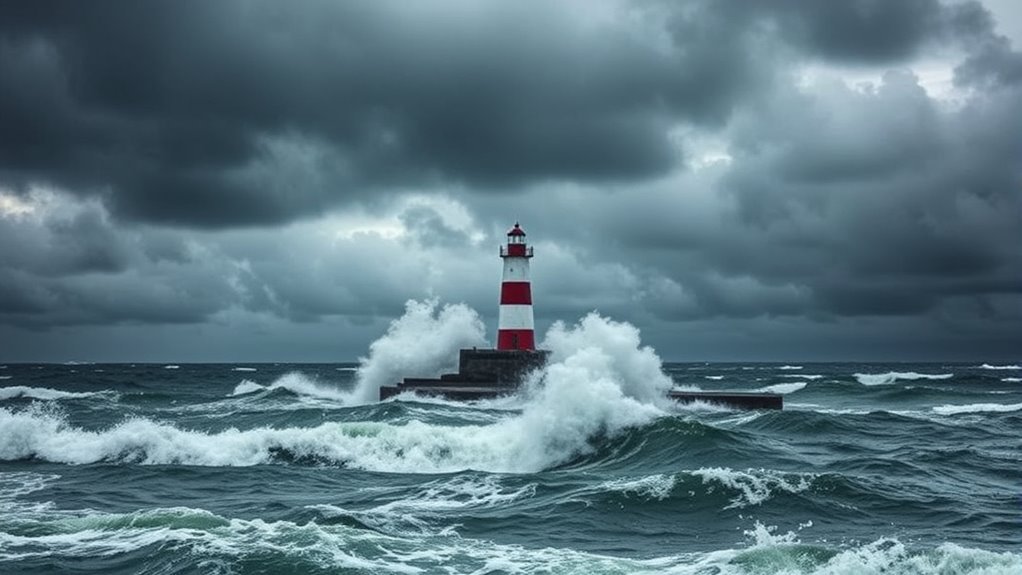Major squalls severely impact cities and coastal regions by causing flooding and overwhelming drainage systems. The damage to infrastructure leads to extensive repair costs and disruptions in public transportation. Emergency response systems can be strained, complicating rescue efforts. Additionally, storms contribute to environmental changes such as coastal erosion and habitat loss. These impacts may reshape local economies long-term, particularly for vulnerable communities. Further observations reveal the strategies for resilience and the role of climate change driving these events.
Main Points
- Major squalls can overwhelm drainage systems, leading to severe flooding and extensive infrastructure damage in urban areas and coastal regions.
- High winds from squalls cause power outages and obstruct emergency response efforts due to debris on roadways.
- Economic recovery from squall damage can reach billions, straining local budgets and increasing insurance rates for residents.
- Public safety systems face challenges during squalls, complicating evacuation efforts and increasing the risk of injuries and fatalities.
- Coastal erosion and habitat disruption from storm surges threaten ecosystems and biodiversity, particularly in vulnerable marine environments.
The Immediate Effects of Major Squalls on Urban Infrastructure
Although major squalls can occur with little warning, their immediate effects on urban infrastructure are often substantial and complex. These intense weather events can lead to severe flooding, overwhelming drainage systems and causing water to inundate streets, buildings, and public transportation hubs.
Power outages frequently accompany squalls, as high winds can down power lines and disrupt electrical services, leaving residents without essential utilities.
Furthermore, debris from damaged structures, including fallen trees and displaced signage, can obstruct roadways, complicating emergency response efforts. Public transportation systems face interruptions, with delays or cancellations affecting commuter travel and accessibility.
In coastal regions, storm surges can exacerbate flooding, threatening critical infrastructure such as seawalls, piers, and harbors. The rapid accumulation of damage necessitates urgent attention and resources for repair, placing immediate strain on city budgets and emergency services, highlighting the vulnerability of urban areas to sudden meteorological changes.
Long-Term Economic Consequences of Severe Storms

Severe storms can lead to considerable long-term economic consequences for affected regions.
The costs associated with infrastructure damage often strain municipal budgets, while insurance rate increases further burden residents and businesses.
Additionally, economic displacement effects may arise as communities struggle to recover, prompting shifts in population and local economies.
Infrastructure Damage Costs
The economic repercussions of infrastructure damage caused by major squalls can be staggering, often reaching billions of dollars in recovery costs. Cities face extensive expenses related to repairing roads, bridges, and public utilities, which can disrupt daily activities and hinder economic productivity.
Additionally, the long-term impact includes the need for upgraded infrastructure to withstand future storms, further escalating financial burdens. Coastal regions may also incur considerable costs related to beach reclamation and seawall construction, which are necessary to protect against erosion and flooding.
These expenses strain local budgets and divert funds from essential services, potentially leading to increased taxes or reduced public investment. In the end, the economic fallout from infrastructure damage can reshape the financial environment of affected communities for years to come.
Insurance Rate Increases
Following the extensive infrastructure damage caused by major squalls, many cities and coastal regions experience considerable increases in insurance rates.
Insurers reassess risk levels, leading to heightened premiums for homeowners and businesses alike. The increased frequency and severity of storms prompt companies to adjust their calculations, often resulting in rate hikes that strain local economies.
Communities already burdened by repair costs find it increasingly difficult to afford necessary coverage, potentially leaving them vulnerable to future disasters.
Additionally, these rate increases can discourage new investments and development in affected areas, stunting long-term economic growth.
As a consequence, residents and businesses face not only immediate financial challenges but also the wider ramifications of rising insurance costs on their general economic stability.
Economic Displacement Effects
Major storms can lead to considerable economic displacement, reshaping the livelihoods of residents in affected areas. The aftermath of severe storms often results in a long-term economic decline that disproportionately affects vulnerable populations.
Communities face notable challenges, including loss of jobs, decreased property values, and increased costs of living.
The emotional toll of such displacement can be deep, manifesting in various ways:
- Families uprooted from their homes, forced to traverse uncertainty and instability.
- Local businesses shuttered, leaving a once-thriving community struggling to survive.
- A pervasive sense of loss, as cultural and social ties dissolve under economic pressure.
These factors contribute to a cycle of poverty and hinder recovery efforts, making the impact of major storms far-reaching and enduring.
Impacts on Public Safety and Emergency Response Systems

Although cities and coastal regions are designed to manage various emergencies, major squalls present unique challenges that can overwhelm public safety and emergency response systems. The sudden onset of severe weather conditions can hinder timely communication, complicate evacuation efforts, and disrupt transportation networks.
Emergency personnel may face difficulties in reaching affected areas due to flooding, debris, or downed power lines, delaying essential assistance.
Moreover, the intensity of squalls can escalate the risk of injuries and fatalities, placing additional strain on medical facilities and first responders. Coordination between agencies becomes vital, yet often chaotic, as resources are stretched thin.
The unpredictable nature of such storms can lead to insufficient preparation, leaving communities vulnerable. In this situation, the effectiveness of disaster response plans is tested, highlighting the need for improved strategies and infrastructure to boost resilience against future squall events.
Environmental Changes Induced by Major Squalls

Major squalls greatly contribute to environmental changes in coastal regions, primarily through coastal erosion and habitat disruption.
The intense winds and heavy rainfall associated with these storms can rapidly alter shorelines, leading to the loss of land and critical ecosystems.
Additionally, the disturbances caused by squalls can displace wildlife and disrupt local habitats, further exacerbating ecological challenges.
Coastal Erosion Effects
Coastal erosion represents a substantial environmental change triggered by the intense forces of squalls. These violent weather events release powerful winds and surging waves, which persistently batter coastlines, leading to notable land loss.
As the shoreline recedes, the ramifications extend beyond mere geography, affecting both the ecosystem and human settlements.
The emotional impact of coastal erosion can be deep, as it brings about:
- Loss of homes: Families are displaced as their properties succumb to the unyielding sea.
- Devastated livelihoods: Fishing and tourism industries suffer, threatening local economies and jobs.
- Cultural heritage at risk: Historic sites and community landmarks may vanish, erasing local identity and history.
In this way, coastal erosion serves as a stark reminder of nature's power and fragility.
Habitat Disruption Consequences
The impact of squalls extends beyond coastal erosion, markedly disrupting habitats in both marine and terrestrial environments.
In marine ecosystems, turbulent waters can displace or destroy fragile coral reefs, leading to a decline in biodiversity. The influx of freshwater and pollutants alters salinity levels, further stressing aquatic life.
Terrestrial habitats also face considerable challenges, as high winds can uproot trees, damage vegetation, and disrupt animal nesting sites. This habitat fragmentation forces wildlife to modify quickly or face extinction.
Additionally, altered terrains can lead to increased competition for resources among species.
Altogether, the consequences of habitat disruption from major squalls can result in long-term ecological imbalances, threatening both species survival and ecosystem resilience in affected areas.
Case Studies of Cities Affected by Major Storms

Cities around the world have faced considerable challenges from severe storms, highlighting the vulnerabilities intrinsic to urban environments. Remarkable case studies illustrate the devastating impact of major squalls on urban infrastructure and communities.
- New Orleans, USA: Hurricane Katrina in 2005 exposed the city's inadequate levee systems, resulting in catastrophic flooding and loss of life.
- Hurricane Sandy, USA: Striking in 2012, it inundated parts of New York City, leading to considerable economic losses and displacement of thousands of residents.
- Typhoon Haiyan, Philippines: In 2013, this storm devastated Tacloban, causing widespread destruction and highlighting the dire need for disaster preparedness in vulnerable coastal regions.
These examples underscore the urgent need for cities to acknowledge and address their susceptibility to severe weather events, as the aftermath often leaves lasting scars on affected communities.
Strategies for Urban Resilience Against Major Squalls
Numerous strategies exist for improving urban resilience against major squalls, focusing on proactive measures that can mitigate the impacts of severe weather.
Urban planners advocate for the development of green infrastructure, such as permeable pavements and green roofs, which can reduce stormwater runoff and alleviate flooding. Additionally, implementing robust early warning systems is critical, enabling residents to prepare for impending squalls.
Cities can also invest in fortifying key infrastructure, such as bridges and drainage systems, to withstand extreme weather events. Community engagement plays an essential role, cultivating awareness and preparedness among residents through education and training programs.
Moreover, establishing emergency response plans guarantees a coordinated effort during and after a squall.
Finally, strategic land-use planning, which includes zoning regulations that discourage development in high-risk areas, is fundamental for long-term resilience. Collectively, these strategies can greatly improve urban areas' ability to withstand the challenges posed by major squalls.
The Role of Climate Change in Increasing Squall Intensity
Recent research indicates that climate change greatly contributes to the increasing intensity of major squalls. Rising global temperatures lead to higher sea surface temperatures, which can intensify storms and produce more severe squalls. This phenomenon threatens urban areas and coastal regions, exacerbating the risks posed by extreme weather.
The consequences of this trend are significant:
- Devastation of Communities: Increased squall intensity can lead to catastrophic damage, displacing families and destroying homes.
- Economic Strain: Hard-hit areas face soaring repair costs, straining local economies and diverting resources from essential services.
- Health Risks: Flooding and storm damage can promote public health crises, exposing vulnerable populations to increased risks of disease and injury.
As climate change continues to evolve, the urgency to address its role in squall intensity becomes critical for safeguarding lives and livelihoods.
Common Questions
How Do Major Squalls Affect Mental Health in Affected Communities?
Major squalls can lead to increased anxiety, depression, and post-traumatic stress in affected communities. The unpredictability of such events disrupts daily life, resulting in heightened stress and a sense of loss among residents.
What Roles Do Local Businesses Play During Squall Recovery Efforts?
Local businesses serve as crucial support systems during recovery efforts, providing essential goods, services, and employment opportunities. They cultivate community resilience by facilitating resource distribution, offering safe spaces, and promoting local engagement in rebuilding initiatives.
How Are Schools Prepared for Major Squalls?
Schools implement emergency plans, conduct drills, and establish communication networks to guarantee safety during major squalls. Preparedness includes securing facilities, training staff, and providing resources to support students and families throughout the recovery process.
What Technology Helps Predict and Track Major Squalls?
Advancements in meteorological technology, including satellite imagery, Doppler radar, and computer modeling, improve the prediction and tracking of major squalls. These tools enable accurate monitoring of storm patterns, enhancing preparedness and response strategies for affected areas.
How Do Major Squalls Impact Wildlife in Urban Areas?
Major squalls disrupt urban wildlife by destroying habitats and displacing species. Increased flooding and debris can hinder animal movement, while altered food sources create challenges for survival, eventually affecting biodiversity within urban ecosystems.

